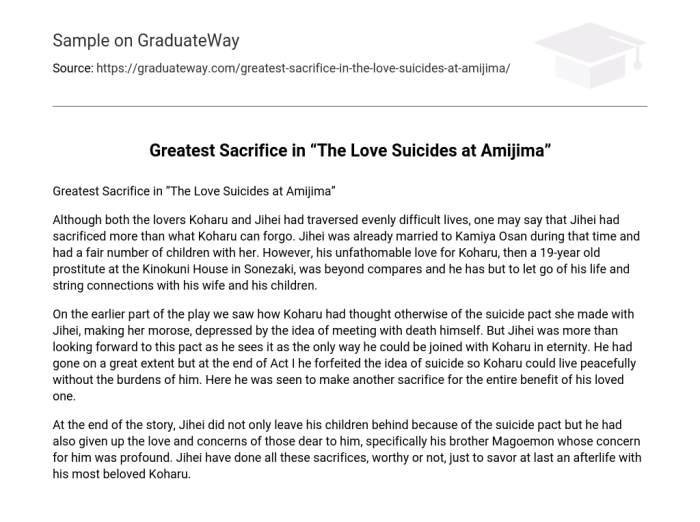Love suicides at amijima summary – Love Suicides at Amijima: A Historical and Literary Exploration delves into the tragic incident that captivated Japan and inspired numerous artistic interpretations. This captivating narrative unravels the historical context, characters, and themes surrounding this enigmatic event.
The Amijima incident, a double suicide pact between two young lovers, occurred in 1723 and has since become a subject of fascination and intrigue. This Artikel provides a comprehensive examination of the incident, exploring its social, cultural, and psychological dimensions.
Love Suicides at Amijima: Historical Context: Love Suicides At Amijima Summary

The Amijima incident, a renowned double suicide that occurred in 1721, holds significant historical and cultural significance in Japan. This tragic event took place on the island of Amijima in Osaka Bay, where two young lovers, Tokubei and Ohatsu, took their own lives together.
The incident gained notoriety due to its unique circumstances and the social and cultural factors that contributed to the lovers’ decision. These factors included the strict social hierarchy and rigid societal norms of the Edo period, which often prevented individuals from pursuing romantic relationships outside of arranged marriages.
The incident had a profound impact on Japanese society and literature, inspiring numerous works of art, literature, and theater. It became a symbol of the struggles and sacrifices that people were willing to make for love and the importance of individual freedom and expression.
Characters and Motives, Love suicides at amijima summary
Tokubei, a young fishmonger, and Ohatsu, a former prostitute, fell deeply in love despite their different social backgrounds. However, their relationship was met with strong opposition from both their families and the community.
Faced with societal disapproval and pressure, the couple made the tragic decision to end their lives together. Their suicide was seen as a form of protest against the oppressive social norms and a desperate attempt to preserve their love.
Thematic Analysis
The Amijima incident raises important questions about love, loss, and the human condition. It explores themes of social conformity, the power of love, and the consequences of societal pressure.
The characters’ decision to take their own lives highlights the profound impact that societal norms and expectations can have on individuals. It also raises questions about the nature of love and the lengths people are willing to go to for it.
Literary and Artistic Depictions
The Amijima incident has been the subject of numerous literary and artistic works, including plays, novels, and films. These works have explored different aspects of the incident and offered various interpretations of the characters’ motivations and the significance of their actions.
One notable example is the play “Love Suicides at Amijima” by Monzaemon Chikamatsu, which dramatizes the incident and explores the themes of love, duty, and social obligation.
Modern Relevance
The Amijima incident continues to resonate in modern times as a reminder of the challenges and sacrifices that people face in pursuit of love and happiness. It sheds light on the importance of individuality and the need for a more tolerant and compassionate society.
The incident also serves as a cautionary tale about the dangers of societal pressure and the need to challenge oppressive norms that prevent people from living their lives authentically.
FAQ Insights
What were the primary factors that contributed to the Amijima suicides?
Social norms, economic hardship, and the strictures of feudal society all played significant roles in the decision of the two lovers to take their own lives.
How has the Amijima incident been depicted in Japanese literature and art?
The incident has been the subject of numerous works of literature, theater, and film, each offering unique interpretations and perspectives on the tragedy.
What lessons can be learned from the Amijima incident?
The incident highlights the importance of understanding the pressures and challenges faced by individuals in different historical and cultural contexts.

